Preface
Here I will provide a brief overview of historic mid 19th to mid 20th century Indigenous canoe races in the Gorge Waterway. I will also include an appendix with an Indigenous canoe related story, reported in 1936, to make it more accessible for students.
Indigenous stories on the southern coast of British Columbia often included explanations of how physical objects such as nets and spears were first given to them and how people gained the knowledge about how to use them. One of those stories involved the discovery of adze blades and their use in canoe making and the supernatural prerogatives involved. It was recorded by Beryl Cryer (1889-1980), who acquired many Indigenous stories, many of which came from her long conversations with Penelakut elder Tzea-Mntenaht (1855-Dec. 3, 1949), whose English name was Mary Rice. Mary was the grand daughter of Chief Hulkalastun of Penelakut and Chief Capilano of Squamish. I have inserted a photograph of Mary Rice into the appendix story. Figure 8, shows Mary visiting the Old Songhees Reserve during the canoe races in 1911.
The Historic Gorge Races
Boat Regattas on the Gorge Waterway were first started during the gold rush of 1858, by America visitors to Victoria celebrating their Independence Day on the 4th of July. The local British fearing an American takeover of the Colony forbid these celebrations and encouraged their replacement by Celebrations of Queen Victoria’s birthday on the 24th of May.
Indigenous canoe racing became part of the larger Gorge Regatta which involved hundreds of people bringing boats up the Gorge for picnics and festivities. In the area just below the Gorge reversable falls, under the Tillicum Road Bridge, the Navy strung colourful banners across the waters. There were boat races of every description. Races among Navy personnel, local clubs, Chinese boat races and the most popular Indigenous canoe races. It was a formal event with local dignitaries handing out prizes (Figure 1 & 2). The James Bay Athletic Association played an important role and always hosted a reception in their large tent.


In the late 1860s and 1870s, these regattas were smaller and less regular. Separate races were held for “Southern Indians”, mostly peoples who spoke languages of the Salish language family from southern Vancouver Island and northern Washington State, and for “Northern Indians” such as the Haida, Heiltsuk (Bella Bella), Nuxalk (Bella Coola) and several Kwakwala speaking tribes.
By the 1890s, it was mostly Southern Indigenous peoples who were involved in the races. The canoe entries for 1895, included the local lək̓ʷəŋən and SENĆOŦEN, and various Cowichan and Chemainus area bands from the east coast of the Island, the Ditidaht from the Nitinaht region of the west coast of the Island and the Snohomish and Lummi from Washington State. The Indigenous competition included men’s and women’s races (Figure 6). A 30-foot War Canoe Race was run, but the race that most people got excited about was the less common 40-foot War Canoe race.
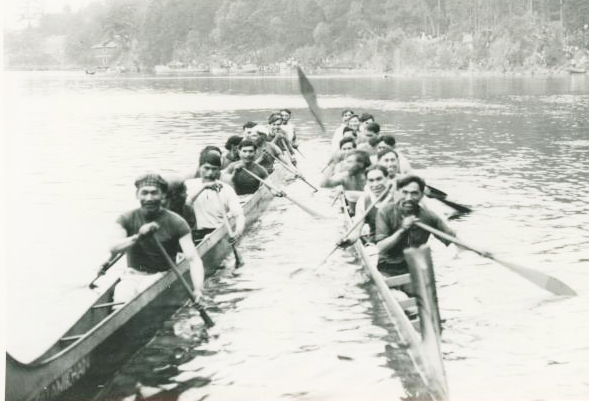
Figure 4, shows a visiting team from the Cowichan Westholme Reserve. They are preparing to launch their canoe from the East shore of Hope Point in Victoria West. Early 1900s. Left to right are Big Joe, Jack Norris (1865- Jan. 8, 1940), Ed Norris (1881-Aug. 16, 1956), Louie Norris 1875- June 7, 1952), Sta-tsun, unknown, Freddie Joe, Moses Seymour (Aug. 31, 1890-July 30, 1957), Johnny Norris (1867- Oct. 24, 1947), Big Brown and David Jack.

The larger traditional canoes soon disappeared and local boat builders, like SȾÁ,UTW̱ (Tsawout) band members, Marshall Harry (1877-Dec. 7, 1958) and Edwin Underwood, started a new type of racing canoe that was a cross between a long English racing canoe and local Indigenous designs. The latter were often mistakenly referred to as “War canoes” in the newspapers, to built the excitement of the races.
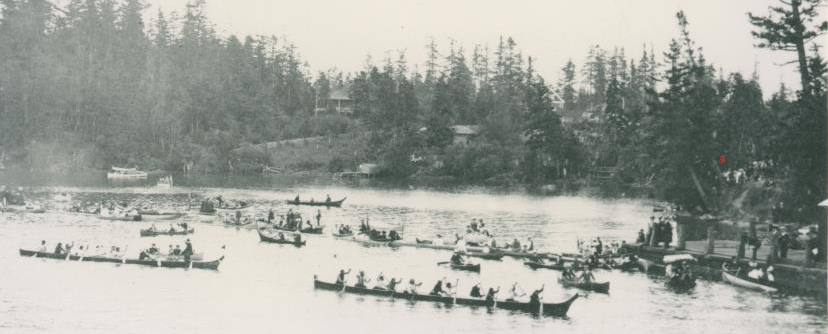
The “War Canoe Races” started from a barge near the Gorge falls and moved east down the Gorge to and around Halkett Island in Selkirk Waters and back. To start the races a bugle was blow for two minutes and then a gun fired. In 1876, a Songhees canoe won the approximately 3.2 km race in a time of 15 minutes.
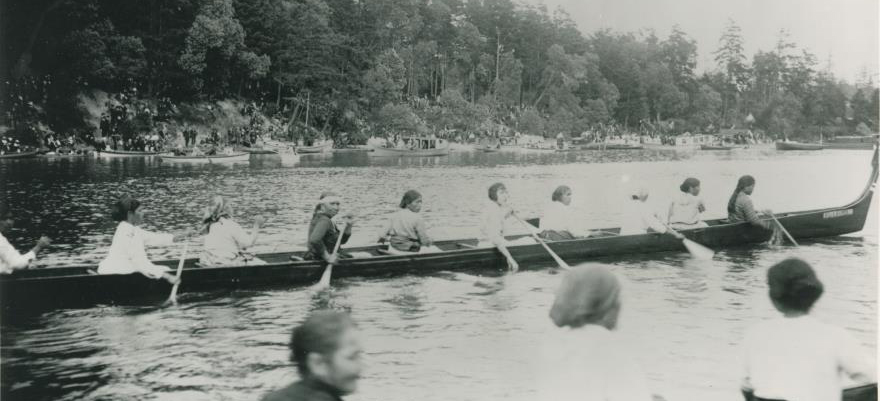
After the 1900s the Indigenous canoe races were sometimes started in the inner harbour (Figure 7). By then, only the new specially designed, slender racing canoes were used. In the 1920s and 1930s Indigenous people organized most of their own races at other locations but continued to be part of the Gorge Regatta celebrations. After the start of World War II, the Gorge races became less regular. They stopped about 1948, and were then held on the Gorge waterway only on special occasions. However, canoe races continued as a thriving sport on lower island reserves, as they do to this day.
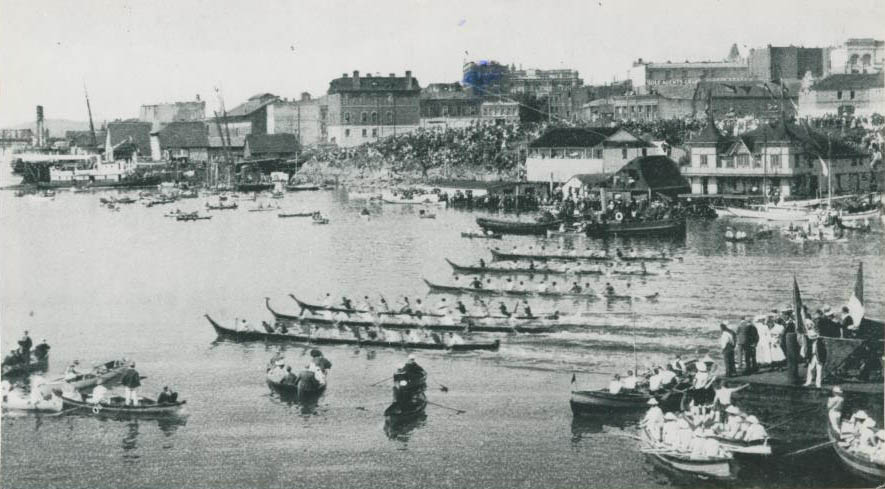
Appendix 1.
The Flying Canoe. By Beryl Cryer.
Many, many, years ago, long before any white people lived in this land, there was a very big tribe of Indians at a place called Nanoose Bay. They were fine, strong people, and for a long time they all lived together in peace. Then, one day, two of their young men did something-I don’t know what it was – but it must have been very bad, for the rest of the tribe drove them away and would not have anything to do with them.
So, the two boys started off to find a place where they could make a home for themselves.
Away into the woods they wandered, traveling up high hills and down into shady, mossy valleys, by silver lakes, and through quiet, dark forests where the sun never showed his face. One morning, after climbing and climbing. they found themselves on the top of a high mountain. They were oh! so tired! and. feeling that they could not go another step, they lay down on some soft, brown moss, and were soon fast asleep.
How quiet it was up there! Not a bird singing, not a sign of deer feeding on the juicy green grass which grew under the shady trees! It seemed as though the whole world must be fast asleep.
Suddenly there was a noise, with one jump the boys were on their feet. “What was it?” “Listen! Don’t move!” Not daring to breathe, they stood waiting for the sound to come again. “Ah! there it was again!” “Serraape, Serraape, Serraaapeee!”. Over and over, it came; the very air seemed filled with the curious sound, but not a thing moved in the bushes, and there was no sign of any living creature about. Still the noise kept on, some- times loud, sometimes soft! Stepping very carefully, to make no sound. they stole forward, peering under logs, and through bushes, until at last, following the direction from which the noise came, they crept through a thick clump of small fir trees and stood in wonder at the sight that met their eyes.
An Old, Old Game
Just ahead of them was a cleared space in the woods, and there stood an old, old man! He was all withered and bent, just as trees are bent when they grow out on rocks, with nothing to shelter them from the Winter winds; and the boys could see at once that he was blind. But it was the thing in his hands that they could not understand! Never had they seen anything like it before!
It was a large stone, shaped and sharpened at one end, and, as they stood watching, the boys saw him take the stone and, leaning over a great tree that lay on the ground beside him, he drew this curious stone along it, cutting large pieces from the side. And as he did this, they again heard the loud “Secraape, scraape” that had frightened them so badly.
Looking about, they saw that behind the man was another tree lying on the ground, but this was cut on the outside and the inside had. been taken away so that it was hollow! “Now, what can that tree be for?” they whispered to each other, “and how can the man have knocked down such a fine tree? for it is not old and rotten, but quite green and strong!”-Now they saw that on the ground beside the man lay another sharpened stone, but this was different: it had a handle.
One boy whispered to the other, “There is the thing he knocks the trees down with! Let’s steal it, for he can’t see us!” So, very, very softly they crept forward to steal the old man’s tools. Not a twig snapped under their feet, not even a leaf brushed their bodies, and yet, in some wonderful way that old man heard them, for he turned his head quickly and called out, “Who are you? Where are you?”
Down in the grass crouched the boys, and not a word did they answer him! Then he called again, “Wait, whoever you are! Do not steal my tools, they would be no use to you, for you do not know how to use them! Give them back to me and I will teach you how to knock these great trees to the earth, and how to make canoes in which you can ride on the water; and I will give you a poison to kill with, and a medicine to make the dead live again!”
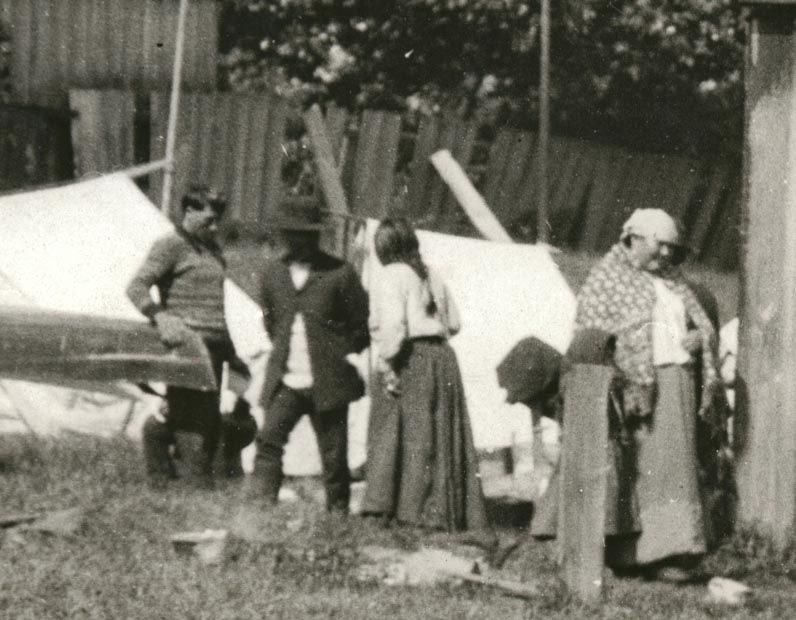
Boys Make a Promise
Then the boys got up from the grass where they were hiding and walked up to the man, thinking that they might pick up his tools and run away with them. But the poor old man begged so hard that they would leave him his precious tools that at last they promised they would not take them, but would, instead, stay and help him make his canoes. In return he promised that he would give them a canoe, and knives that they could fight with, besides all the other things he had told them of!
Oh! but I can’t tell you how happy that old man was when they said they would stay! He took them by their hands and begged them to come with him to his house. So back they all went together, for you may be sure that the boys were tired of sleeping under trees and logs, and the thought of a warm house and perhaps a good meal of deer meat made them hurry the old man along rather more quickly than he was used to walking.
When they saw the house, they stopped and stared! Never had they dreamed of such a house! Why, it was made of wood! Thick planks cut from trees with those wonderful tools the old man had! And what a size it was! High! Even higher than a man could reach! It was most wonderful. You see, they had only seen little houses made of skins or, sometimes of cedar bark.
At last, they went inside and there they found the man’s wife and, beside her, their little baby. The boys were very happy in their new home. Every day they would go out with the man and he would teach them to make the canoes that would ride on the water, and how to use the medicine he made.
At last, their canoe was finished and they were ready to leave, when suddenly a dreadful thought came to them. “How were they going to get their canoe down to the water? “How foolish we are!” exclaimed one, “We have made our canoe up on top of this high mountain! We can never carry it all the way down!” When the old man heard them, he laughed, and laughed, until the tears ran down his cheeks. “Get in!” he cried, “get in, and I will each you how to sing to your canoe!”
Their Precious Canoe
The boys carried their precious canoe to the middle of the clearing and there they propped it up with stones, to keep it steady. Then in they got, very carefully, so as not to tip it over, and the old man got in with them.
Sit quietly,” said the man, “and listen to me, but do not talk. Then he took the paddle in his hands and, putting it over the edge, began to tap, tap, tap, tap, tap on the side of the canoe, and as he tapped, he sang a low, swinging sort of song.
Softly, softly he tapped and sang his song to the canoe. Then gradually the tapping got quicker and quicker. The old man’s voice, which at first had seemed weak and quavering. grew stronger and stronger until the music, of it filled the woods about them with its sweetness! Then suddenly he stopped.
“It is good,” he said, “I cannot teach you any more. Now go, and sing to your canoe as I have taught you!”
Out he climbed and, taking the stone tools, the medicine and the poison in their skin baskets, he put them in the bottom of the canoe. The boys took their paddles and put them over the side as the man had done, and then, so quietly it could scarcely be heard, they tap, tap, tapped on their canoe, and softly their voices rose in the swinging song. Then I wish you could have seen what happened next, for, as the song swelled stronger and louder, so the tapping grew quicker and yet quicker, and then the canoe began to shake and tremble from one end to the other, and slowly. smoothly as a bird flies, it rose from the ground! Up, up, it flew! Up, up, up! until “on looking down the boys could scarcely see the old man.
Ah! then they beat hard with their paddles and their voices rose louder and stronger, as the canoe flew still higher and higher, until it was away above the tree tops, and the boys could see frightened little birds peeping out at them from their nests in the branches. and on they went, over the mountain and over the lakes, and then down, down, down, right into Nanoose Bay!
As they flew over the village where they had once lived the people came running out and, looking up, they called, “See, here are those two boys we drove away! Look! they are flying through the air like birds!” They gathered up handfuls of stones and threw them at the canoe, but the boys took their basket of poison and sprinkled it on the people, so that they were turned to stone.
On they flew until they came to their old home, but here everything was changed. The house of skin had been torn down and burned, and grass and bushes had overgrown everything. “We must get busy!” exclaimed the boys, and, taking their tools, they soon cut down some trees and made them into planks, with which they built a fine new house. When the house was finished, they wandered about looking at all the people they had turned into stone, and one said to his brother, “What a good plan it would be to make a few of these people alive again, for, when they see what good houses we can make, they will not drive us away!
Back to the canoe they hurried and took out the medicine that would make people alive again. This they sprinkled on the stone people and at once they were awake! They seemed quite pleased to see the boys, and when they saw the tools that would knock down trees, and the wonderful house of planks, they laughed and sang with joy.
“Teach us how to knock down great trees!” they cried. “Stay with us, and show us all the wonders you have learned!”
So, the boys stayed with the tribe, and taught them everything that the old man had shown them; and, best of all, they taught them how to make canoes that would ride on the waters, and the chief of the tribe called them “Canoe Makers.” (Cryer, 1936).
Reference
Cryer, Beryl 1936. The Flying canoe. The Daily Colonist. July 5, 1936, Page 4 & 7.